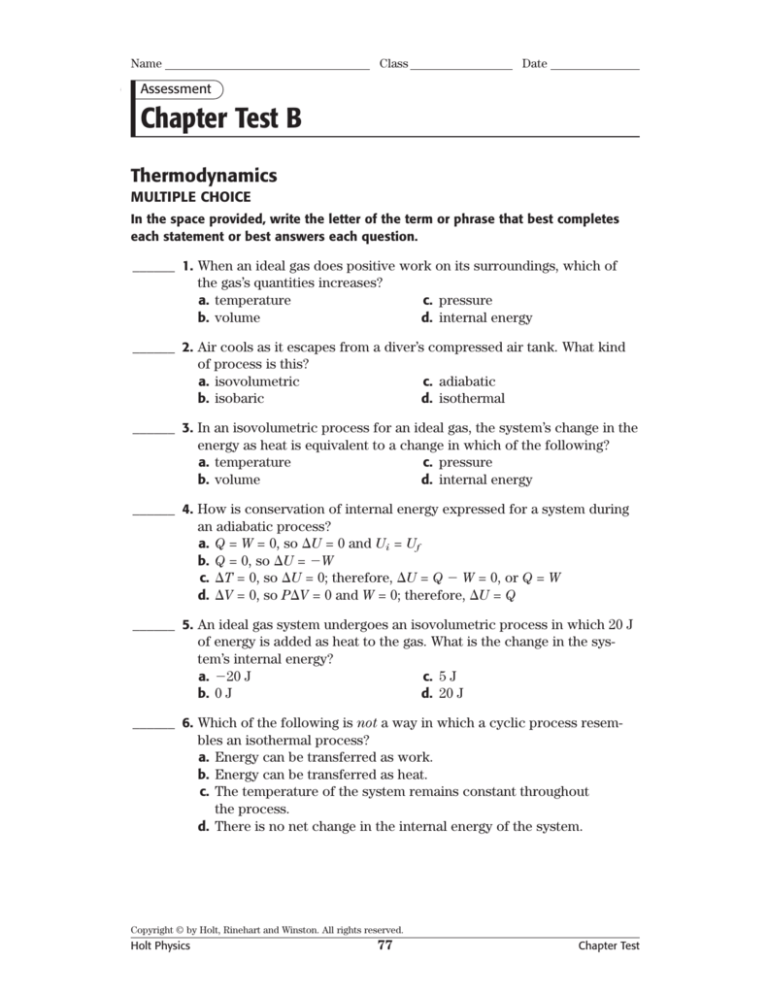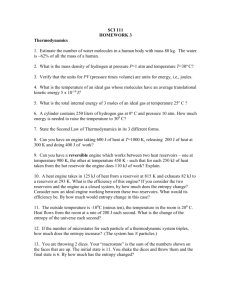
Name
Class
Date
Assessment
Chapter Test B
Thermodynamics
MULTIPLE CHOICE
In the space provided, write the letter of the term or phrase that best completes
each statement or best answers each question.
______ 1. When an ideal gas does positive work on its surroundings, which of
the gas’s quantities increases?
a. temperature
c. pressure
b. volume
d. internal energy
______ 2. Air cools as it escapes from a diver’s compressed air tank. What kind
of process is this?
a. isovolumetric
c. adiabatic
b. isobaric
d. isothermal
______ 3. In an isovolumetric process for an ideal gas, the system’s change in the
energy as heat is equivalent to a change in which of the following?
a. temperature
c. pressure
b. volume
d. internal energy
______ 4. How is conservation of internal energy expressed for a system during
an adiabatic process?
a. Q = W = 0, so !U = 0 and Ui = Uf
b. Q = 0, so !U = "W
c. !T = 0, so !U = 0; therefore, !U = Q " W = 0, or Q = W
d. !V = 0, so P!V = 0 and W = 0; therefore, !U = Q
______ 5. An ideal gas system undergoes an isovolumetric process in which 20 J
of energy is added as heat to the gas. What is the change in the system’s internal energy?
a. "20 J
c. 5 J
b. 0 J
d. 20 J
______ 6. Which of the following is not a way in which a cyclic process resembles an isothermal process?
a. Energy can be transferred as work.
b. Energy can be transferred as heat.
c. The temperature of the system remains constant throughout
the process.
d. There is no net change in the internal energy of the system.
Copyright © by Holt, Rinehart and Winston. All rights reserved.
Holt Physics
77
Chapter Test
Name
Class
Date
Chapter Test B continued
______ 7. A heat engine has taken in energy as heat and used a portion of it to
do work. What must happen next for the engine to complete the cycle
and return to its initial conditions?
a. It must give up energy as heat to a lower temperature so work can
be done on it.
b. It must give up energy as heat to a higher temperature so work can
be done on it.
c. It must do work to transfer the remaining energy as heat to a lower
temperature.
d. It must do work to transfer the remaining energy as heat to a higher
temperature.
______ 8. An electrical power plant manages to transfer 88 percent of the heat
produced in the burning of fossil fuel to convert water to steam. Of the
heat carried by the steam, 40 percent is converted to the mechanical
energy of the spinning turbine. Which best describes the overall efficiency of the heat-to-work conversion in the plant?
a. greater than 88 percent
c. 40 percent
b. 88 percent
d. less than 40 percent
______ 9. When a drop of ink mixes with water, what happens to the entropy of
the system?
a. The system’s entropy increases, and the total entropy of the
universe increases.
b. The system’s entropy decreases, and the total entropy of the
universe increases.
c. The system’s entropy increases, and the total entropy of the
universe decreases.
d. The system’s entropy decreases, and the total entropy of the
universe decreases.
______10. A thermodynamic process occurs, and the entropy of a system
decreases. What can be concluded about the entropy change of
the environment?
a. It decreases.
b. It increases.
c. It stays the same.
d. It could increase or decrease, depending on the process.
Copyright © by Holt, Rinehart and Winston. All rights reserved.
Holt Physics
78
Chapter Test
Name
Class
Date
Chapter Test B continued
SHORT ANSWER
11. A physics textbook is balanced on top of an inflated balloon on a cold morning. As the day passes, the temperature increases, the balloon expands, and
the textbook rises. Is there a transfer of energy as heat? If so, what is it? Has
any work been done? If so, on what?
12. A gas is confined in a cylinder with a piston. What happens when work is
done on the gas?
13. What changes can be made to the transfer of energy as heat to a heat engine
in order to increase the amount of work done by the engine?
14. Describe how energy is transferred as heat during the part of an engine cycle
where the engine does work on the environment and during the part of the
cycle when work is done on the engine.
15. Use the second law of thermodynamics and the equation for heat engine
efficiency to show why efficiency must always be less than 1.
Copyright © by Holt, Rinehart and Winston. All rights reserved.
Holt Physics
79
Chapter Test
Name
Class
Date
Chapter Test B continued
16. Ice cubes are formed in the freezer compartment of a refrigerator. Explain
the change in entropy of the water freezing, as well as the change in entropy
of the environment outside the refrigerator. Does the water freezes spontaneously, and if not, why not?
PROBLEM
17. An ideal gas is maintained at a constant pressure of 7.0 # 104 N/m2 while
its volume decreases by 0.20 m3. What work is done by the system on its
environment?
18. Over several cycles, a refrigerator compressor does work on the refrigerant.
This work is equivalent to a constant pressure of 4.13 # 105 Pa compressing a
circular piston with a radius of 0.019 m a distance of 25.0 m. If the change in
the refrigerant’s internal energy is 0 J after each cycle, how much heat will the
refrigerant remove from within the refrigerator?
19. A steam engine takes in 2.06 # 105 J of energy added as heat and exhausts
1.53 # 105 J of energy removed as heat per cycle. What is its efficiency?
20. The gas within a cylinder of an engine undergoes a net change in volume of
1.50 # 10"3 m3 when it does work at a constant pressure of 3.27 # 105 Pa.
If the efficiency of the engine is 0.225, how much work must the engine give
up as heat to the low-temperature reservoir?
Copyright © by Holt, Rinehart and Winston. All rights reserved.
Holt Physics
80
Chapter Test









